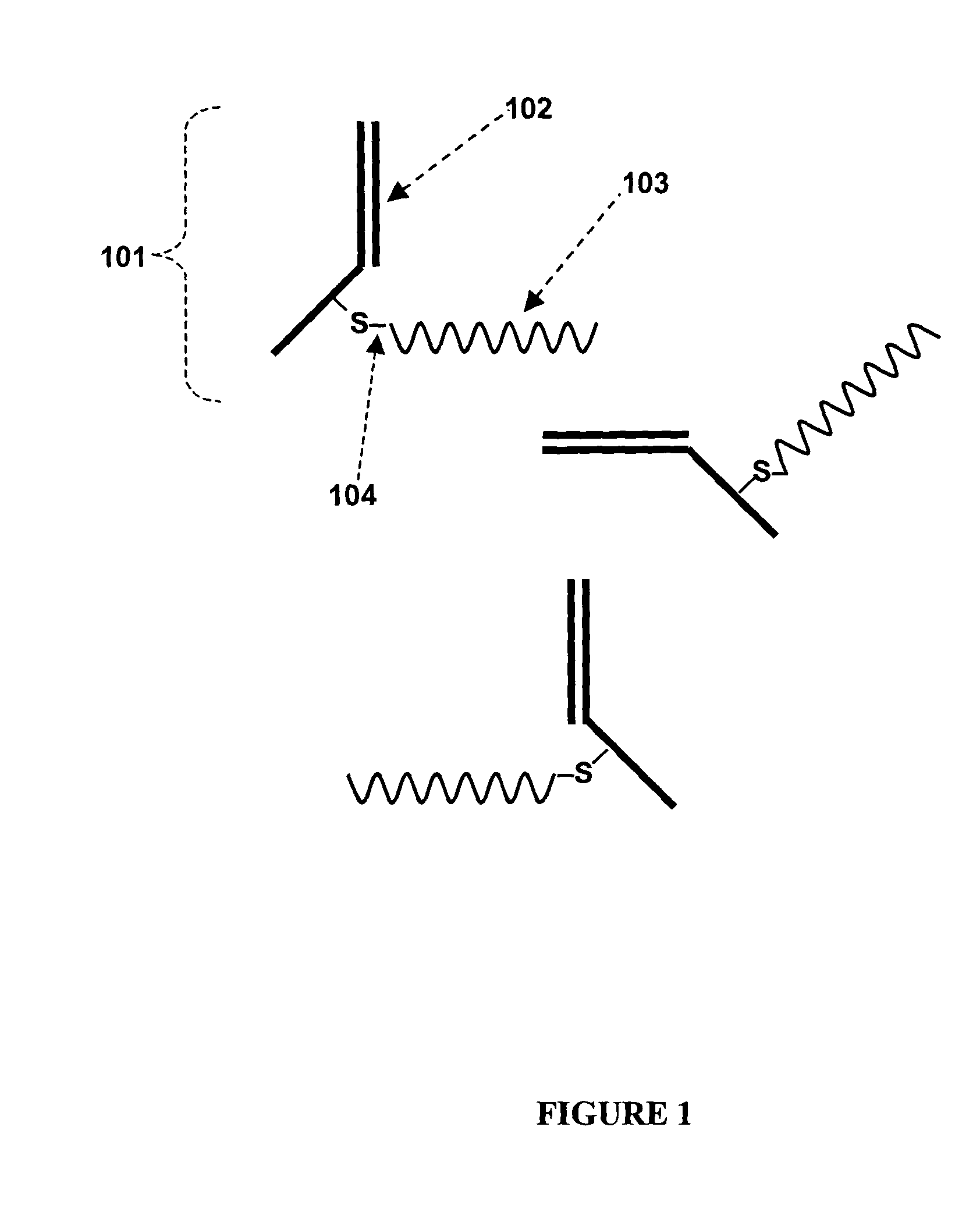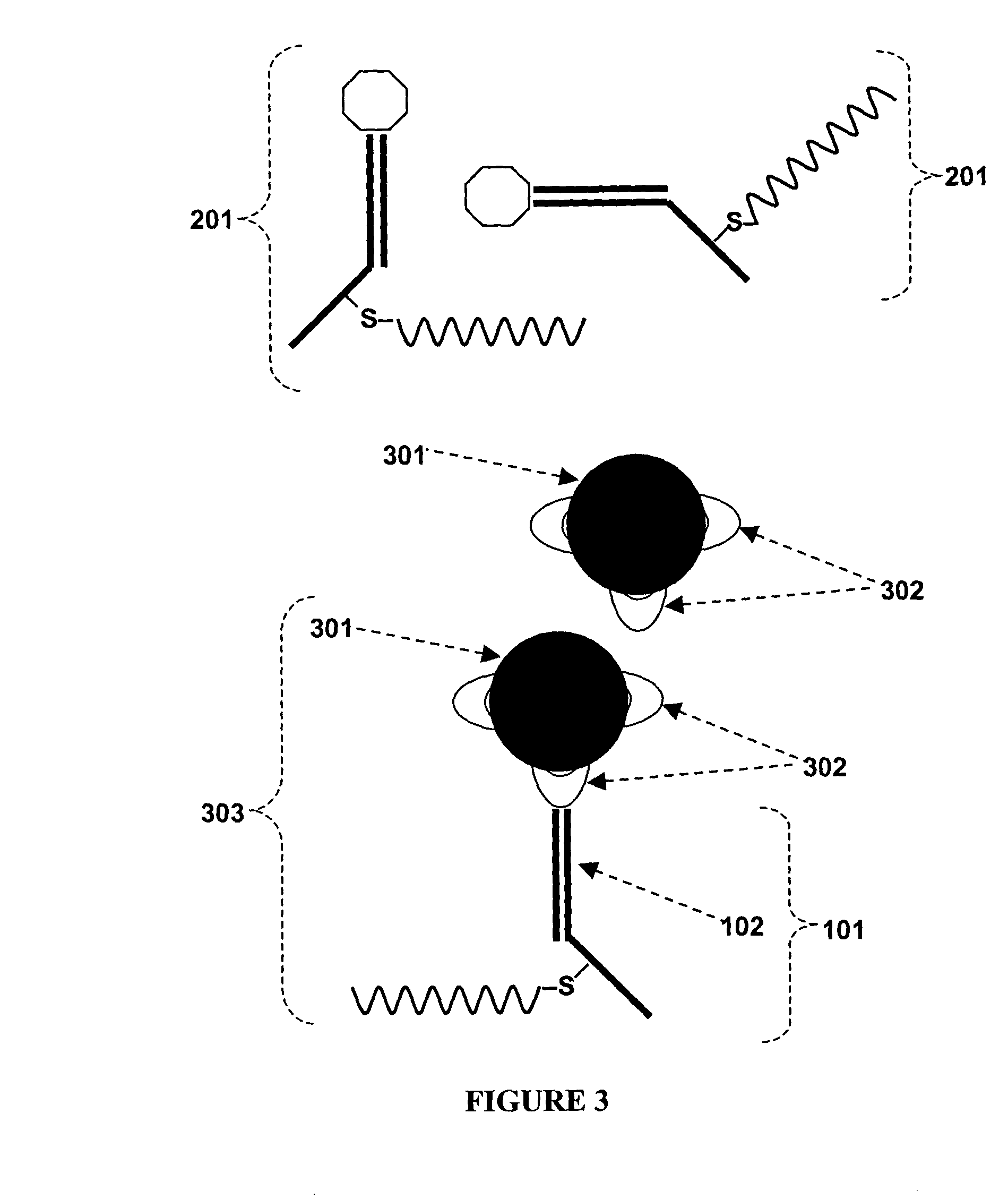Soluble analyte detection and amplification
a technology of soluble analyte and detection method, which is applied in the field of compound detection, can solve the problems of limited sensitivity of all these assays, and is sensitive to contamination from the environment, and achieve the effect of increasing the sensitivity of solution-phase detection and increasing the sensitivity of compound detection
- Summary
- Abstract
- Description
- Claims
- Application Information
AI Technical Summary
Benefits of technology
Problems solved by technology
Method used
Image
Examples
example i
A Non-Limiting Embodiment of a Method for Detection of a Compound of Interest in a Sample
[0077]FIG. 1 depicts a plurality of binding constructs for use in a method of the present invention, as described in Example III. Each binding construct 101 includes a recognition portion 102, which recognizes and binds the compound of interest, and a nucleic acid portion 103. In this embodiment, the recognition portion 102 preferably includes a Fab fragment, such as a Fab fragment made by cleaving the disulfide bridge of the heavy chains of a monoclonal antibody against the compound of interest. In this embodiment, the nucleic acid portion 103 preferably includes DNA. The recognition portion 102 can be attached to the nucleic acid portion 103 through a covalent bond 104, for example, through a covalent bond between the nucleic acid portion 103 and the free sulfhydryl of the Fab fragment of the recognition portion 102.
[0078]FIG. 2 shows a number of binding constructs 101 that have been mixed w...
example ii
Preparation of the Magnetic Particles Bearing Mimotopes
[0081] This example provides one non-limiting embodiment of the present invention wherein the surfaces are magnetic particles bearing peptide mimotopes as the accessible binding targets. In this model system, an antibody that recognizes a bacterial cell wall protein, the Moraxella catarrhalis OMPE protein, was used. A bacterial recombinant fragment of M. catarrhalis OMPE protein was provided by Dr. Timothy Murphy at the University of Buffalo and used as the immunogen for preparing monoclonal antibody 12D.5 (Mab 12D.5). Using overlapping peptide mapping, the antigenic epitope was shown to reside within amino acids 187-220 of the recombinant fragment. A peptide corresponding to this epitope, designated Mopep2, was synthesized with an N-terminal cysteine for post-synthesis attachment to free sulfhydryl-binding structures. Mab 12D.5 was cleaved into two Fab fragments using 2-mercaptoethylamine HCL (Pierce) leaving a reactive sulfhy...
example iii
Preparation of the Binding Construct
[0084] This example provides one embodiment of the binding construct in which an Fab fragment is used as the recognition portion of the binding construct. The plasmid pUC 19 was purchased from Invitrogen and plasmid DNA was linearized by EcoRI. The linearized pUC19 DNA was extracted and purified from agarose gel. This DNA was attached to the Fab fragment of Mab 12D.5 and served as the nucleic acid portion of the binding construct. Commercially available primers were subsequently used to amplify a 1 kilobase fragment from the linearized pUC19 template. To generate a DNA fragment that would be attached to the 12D.5 Fab fragment through the free sulfhydryls (—SH) and serve as the nucleic acid portion of the binding construct, a 5′-psoralen, 3′-amino oligonucleotide was conjugated to a SIAB linker through the available amine. The pUC 1 kilobase DNA was denatured in the presence of excess oligonucleotide and snap annealed to the psoralen using long wa...
PUM
| Property | Measurement | Unit |
|---|---|---|
| pH | aaaaa | aaaaa |
| total volume | aaaaa | aaaaa |
| concentration | aaaaa | aaaaa |
Abstract
Description
Claims
Application Information
 Login to View More
Login to View More - R&D
- Intellectual Property
- Life Sciences
- Materials
- Tech Scout
- Unparalleled Data Quality
- Higher Quality Content
- 60% Fewer Hallucinations
Browse by: Latest US Patents, China's latest patents, Technical Efficacy Thesaurus, Application Domain, Technology Topic, Popular Technical Reports.
© 2025 PatSnap. All rights reserved.Legal|Privacy policy|Modern Slavery Act Transparency Statement|Sitemap|About US| Contact US: help@patsnap.com



